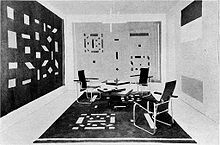“De Stijl”
……
De Stijl was an art magazine, as well as an
artistic movement founded in the Netherlands in October 1917 by a small group
of architects, designers and artists including Piet Mondrian, Bart Anthony van
der Leck, Vilmos Huszár, Jacobus Johannes Peter Oud, Robert van’t Hoff, Jan
Wils and Georges Vantongerloo. Their
leader was Theo van Doesburg.
De Stijl is generally recognised as the first modern design movement.
The magazine not only gave special prominence to progressive Dutch art and design works but also to certain works produced by other movements, including the Russian Constructivists and the Italian Futurists that I have already written about. It also became a source for public discussions – a good opportunity for a large and wide range of knowledgeable people who wished to debate about art and design.
Painting by Piet Mondrian

Marisa Vodanovich, (2013), De Stijl Movement: Piet Mondrian [ONLINE].
Available at: http://www.pinterest.com/pin/523613894146921539/
[Accessed 12 November 13]
Metz & Co. Showroom
with wall hangings (left and rear walls) and carpet by Bart van der Leck,
and furniture by Gerrit Rietveld
Wikipedia, (2013), Metz & Co showroom [ONLINE].
[Accessed 12 November 13]
Painting by Vilmos Huszár

Marisa Vodanovich, (2013), De Stijl [ONLINE].
Available at: http://www.pinterest.com/pin/523613894146921557/
[Accessed 12 November 13]
Piano lamp (1928) designed by Jacobus Johannes Pieter Oud (Dutch, 1890-1963)
and manufactured by W. H. Gispen
and manufactured by W. H. Gispen

rubyology, (2010), Jacobus Johannes Pieter Oud (Dutch, 1890 - 1963) W. H. Gispen, manufacturer, Piano lamp, 1928 [ONLINE]. Available at:
[Accessed 12 November 13]
austin 3, (2012), Trappaal [ONLINE].
[Accessed 12 November 13]
Design by George Vantongerloo (1918)
austin 3, (2012), George Vantongerloo (1918) [ONLINE]. Available at: http://austincubed.blogspot.com/2012/06/de-stilj-architecture.html
[Accessed 12 November 13]
The Olympic Stadium in Amsterdam (The Netherlands) by Jan Wils (1928)

Neatherlands Architecture Institute, (2008), THE OLYMPIC STADIUM BY JAN WILS (1928) [ONLINE].
[Accessed 12 November 13]
Theo van Doesburg’s “Contra Composition XVI” (1922)

The Charnel-House, (2013), Theo van Doesburg’s “Contra Composition XVI” (1922) [ONLINE]. Available at: http://rosswolfe.files.wordpress.com/2011/08/800px-theo_van_doesburg_contra-composition_xvi.jpg
[Accessed 12 November 13]
De Stijl’s aims were to bring harmony and
purity in art and design, so the members focused on a continuous process of
refinement in art. The beliefs of the
Movement were very philosophical – that art should reflect the mystery and the
order of the Universe. This was revealed
in their works, for example in the design of the red/blue chair by Gerrit Rietveld.
De Stijl Furniture- Red and Blue Chair by Gerrit Thomas Rietveld (1917)
Similarly to Cubism, the works of De Stijl
were geometrical, but using mainly square forms. The works were extremely simple, using
straight lines, right angles, pure primary colours (ie blue, red and yellow) and the so called non-colours (black, white and grey). However, despite their simplicity, the
designs of furniture, interiors, textiles, graphics and architecture were
exceptionally powerful. The characteristics of their architecture and interior
designs were strong geometric forms and coloured sort of blocks that showed
space.
Sideboard (1919) designed by Gerrit Rietveld

Dorotheum , (2013), A rare sideboard, designed by Gerrit Rietveld [ONLINE]. Available at: http://www.dorotheum.com/fileadmin/user_upload/bilder/Presse/Gallery_of_Highlights_09/140_28834_5.jpg
[Accessed 12 November 13]
Although the group of
architects/artists/designers of De Stijl were never formally structured, their
works were highly distinguishing and they had a great influence on the Modern
Movement that was developed later. De
Stijl also affected the development of Fine Arts.
In 1931, upon the death of Theo van Doesburg
(the leader of De Stijl), the magazine ceased to be published. Sadly, the members of the Movement gradually
lost their focus - they did not continue to work on the aims and visions of
their Movement. However, although De
Stijl came to an end, it had an intense effect on architecture and the applied
arts in Europe.
Other References:
Book: Fiell, C.F and P.F, 1999. Design of the 20th Century. 2nd ed. Germany: Taschen
Book: Various contributors, (1999). The Art book. 2nd ed. London, England: Phaidon




No comments:
Post a Comment